Don't wanna be here? Send us removal request.
Text
0 notes
Text
Últimos Recursos [Last Resources], Iván Argote , 2021
instagram
0 notes
Text
‘a capa ‘e Napule

Tra le più famose, sebbene non esattamente una statua “parlante”, spicca Donna Marianna, anche detta ‘a capa ‘e Napule, una testa di una divinità pagana, probabilmente Venere, rinvenuta nel Seicento e creduta a lungo parte di una statua raffigurante la sirena Parthenope. Per questo motivo, la scultura fu considerata, sin da allora, protettrice della città e idolatrata in quanto tale. Ancora nell’Ottocento, quando fu collocata di fronte la chiesa di Santa Maria dell’Avvocata, nei pressi di Piazza Dante, nel giorno di Sant’Anna, si era soliti infatti abbellire la scultura con fiori e nastri e danzarvi intorno. Privata del naso durante i moti guidati da Masaniello nel 1647, Donna Marianna, già molto cara ai napoletani, fu restaurata nella seconda metà del XIX secolo. ‘A capa ‘e Napule è oggi custodita all’interno di Palazzo San Giacomo, sede del Comune di Napoli, da dove continua, o almeno si spera, a vegliare sulle sorti della città partenopea.
0 notes
Text
Soft Power - Sculptural Additions to Petersburg Monuments, Alexandra Pirici, 2014
Alexandra Pirici comments on her participation in MANIFESTA 10
Having finished her series of sculptural additions for MANIFESTA 10, Alexandra Pirici wrote some thoughts on her experience and on the context and the controversy around the Biennial taking place in Russia:
On the subject of calls for a more radical program that specifically addresses the Ukraine situation she comments that: “There are, of course, limits to what it can be done in Russia today with state funding - there was a commission that had to approve the exhibition in the Hermitage and authorisations that needed to be given for all works in public space (as is the case in most places, when concerning the “public” space). Could Manifesta have played a card to avoid this? No, I don’t think there was a card to play as the benefits of having a contemporary art biennial here are hard to emphasise and stress to a majority that strongly disapproves and feels offended by contemporary art and its proximity to the Hermitage (even the taxi driver picking me up from the airport at 2 in the morning had to explain, two minutes into the trip, how disgraceful he finds the whole situation and how everybody thinks Piotrovsky is crazy for letting this happen).
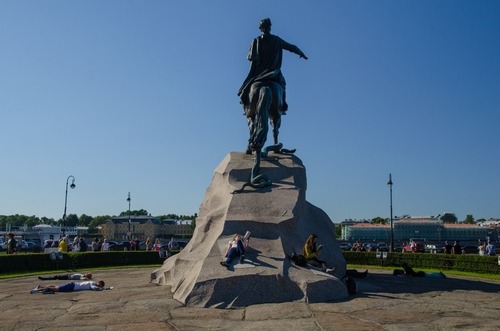
Alexandra Pirici’s Soft Power. 2014. Sculptural additions to Petersburg monuments at the Bronze Horseman, St.Petersburg, June 28,2014. Commissioned for the Public Program of MANIFESTA 10 With the support of the Romanian Cultural Institute.
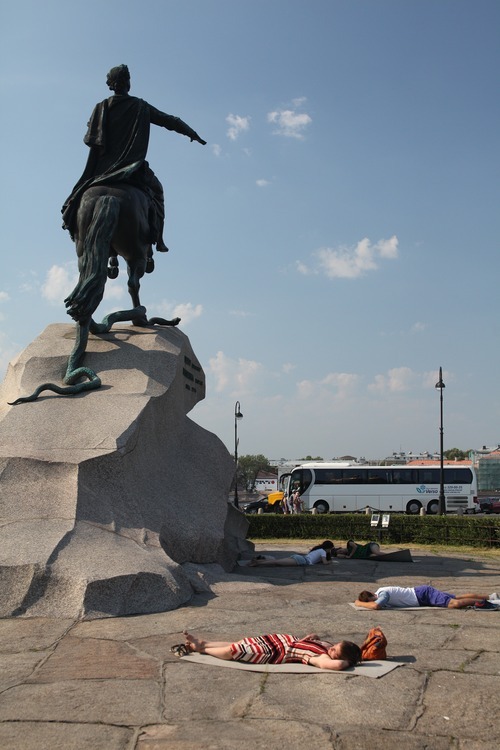
My last intervention at the Bronze Horseman (as minimal as it might have been) – for entangled reasons, was not given permission anymore by a governmental committee two hours before the scheduled start of the performance and then re-approved by a phone call. Whomever thinks it’s not a big deal to sunbathe near the statue I would invite there (not to Berlin), and suggest to protest against a law that apparently puts people in jail for 15 days for it (as we were told by a policeman checking our authorization) and that forbids people to even sit on the grass.
Agreeing to do the action, even in adapted form (as we weren’t allowed to climb on the stone as I initially intended) is not self-censorship but my evaluation of the situation as still being enough to produce something. I do believe that given the context of the artwork, exposing the performers and pushing it into a scandal or outrage - which would make the whole thing stop in 5 minutes, also with consequences for the other people and projects involved - would not have produced a more interesting or significant change.
Even the contradictory reports from the opening – The Calvert writing that my work made a solid point about the interaction of the human and the monumental but failed to attract enough attention - at the same time as Der Standard writing that a passer-by had already insulted and yelled at the performers – both represent a situation in which people also see what they want to see and emphasise what they want to emphasise.
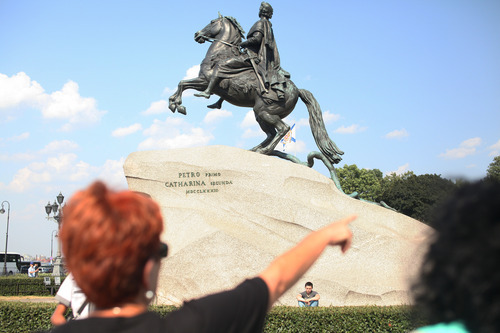
(The previous photos) Alexandra Pirici. Soft Power. 2014. Sculptural additions to Petersburg monuments at the Bronze Horseman, St. Petersburg, July 31, 2014. Commissioned for the Public Program of MANIFESTA 10 With the support of the Romanian Cultural Institute.
To prove that there is censorship and a very brutal propaganda machine at work in Russia today is obsolete. Everybody knows it is there – except for a lot of Russian people who only access information from the media. But the huge support for Putin and Russia’s actions in Ukraine might have multiple and deeper rooted causes that might have to be addressed less abruptly and less directly. This support might be related to a more general fascination with grandiose enterprises and strong leaders, an idea of beauty that is related to greatness and big size (hence the ever-present longing for recovering the empire), my intension was to ‘impress upon or soften’ the strong, unquestionable, unmovable, brave characters and personas and their grand gestures.
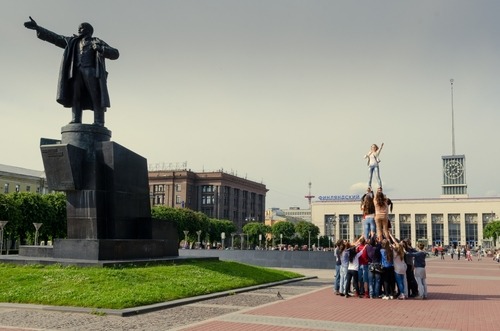
Alexandra Pirici. Soft Power. 2014. Sculptural additions to Petersburg monuments at the Lenin Monument (Finland Railway Station), 3 July, St. Petersburg, 2014. Commissioned for the Public Program of MANIFESTA 10 with the support of the Romanian Cultural Institute.
And what we find beautiful and ugly, right or wrong has, of course, a crucial role in determining how we act and what we support. When we are still fascinated by the neo-classical and the baroque, when we still have a taste for the monumental (be it in the Winter Palace or for Voina’s bridge/phallus work), when you think of less loud gestures as weak and of the minimal and the low-key as ugly, you might also have a taste for corresponding political actions. So aesthetics is political and exposure to different dynamics, different aesthetics and a different discourse might make sense, even if this enterprise is a drop in the ocean considering the level of exposure to the other toxic discourses and the danger of being appropriated and misinterpreted. But who can really quantify the impact and consequences? Given the general audience’s conservatory discontent with the whole event (the Biennial), even if this reaction would be all that Manifesta could produce, I still think it’s more than nothing as it’s also an exercise in tolerance: allowing something to exist even if you do not like it and you do not understand it.
The Biennial, with all its problems and limitations, might be the only politically progressive gesture forced out of Russia in these times of radical conservative backlash. So it might also be a gesture that allows for progressive ideas to be alongside each other and recognise themselves across borders and within different contexts.
Of course, one has to accept this will not save, neither revolutionize the context here. On the symbolic level, an art biennial in Russia might have too little of an impact on both high and low politics. But just as Voina’s phallic critique against the regime turned into support and “masculinity” and patriarchy overcame less important differences and turned old enemies into friends, maybe we should also start looking for allies and similarities rather than agonizing over aestheticizing the political. I respect and understand boycott positions but I honestly think the very little steps and attempts that can be made within Manifesta (and not even those would be possible otherwise) were worth the try and maybe they are more important than the damage we are afraid it might have done. And the appropriation battle is one that we fight everywhere, on all levels, and one that we cannot stay out, even if we wanted to, without risking becoming completely paralysed.
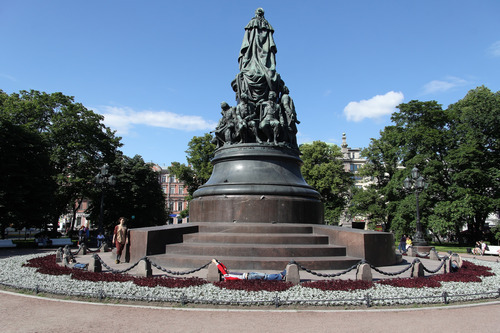
Alexandra Pirici. Soft Power. 2014. Sculptural additions to Petersburg monuments at the Monument to Catherine the Great, Ostrovsky Square, St. Petersburg, June 28, 2014. Commissioned for the Public Program of MANIFESTA 10 with the support of the Romanian Cultural Institute.
Last but not least: prescriptive ideas about political art – turning art into propaganda, in order to be more “efficient”, specific and un-ambiguous, might have helped winning some battles but it didn’t help end the war.
A big thanks to everybody involved.”
Alexandra Pirici
2 notes
·
View notes
Text
0 notes
Text
0 notes
Text

Gospel of Wealth
Performance with Jumoke Adeyanju, Natisa Exocé Kasongo, Thomias Radin, and Maxime Rogron alias Delawhere. Bismarck Momument in Tiergarten, Berlin realized in the frame of Monumental Shadows, Savvy Berlin
0 notes
Text
0 notes
Text
youtube
0 notes
Text
Mwa Ka
Mwa Ka è un monumento in movimento, oggetto di metamorfosi, aperto al flusso al processo, che afferma "la necessità di elaborare un pensiero dinamico e generativo della convivenza"
A seguire, un estratto dal capitolo "metafore e monumenti" del libro Oceania, di Adriano Favole, Editori Laterza
In Place de Cocotiers, cuore della capitale, troneggia fin dal 1897 la statua del generale Jean-Baptiste Olry, il governatore della Nuova Caledonia che nel 1878 represse col sangue l'insurrezione dei Kanak capeggiata da Ataï. Fu solo nel 1974, a partire dalle proteste dei Foulards Rouges, che venne rimosso dalla base del monumento uin. bassorilievo che rappresentava alcuni kanak prostrati davanti al governatore in segno di resa e deferenza. La statua di Orly per il momento resiste al suo posto (...) anche se non mancano iniziative che ne chiedono la rimozione. (...)













Nel 2003, il Comitato "150 ans après", un'emanazione dell'Associazione per i diritttidei popoli autoctoni, aveva deciso di erigere il primo monumento kanak a Nouméa (...) Narcisse Decoiré, uno scultore originario della tribù di Saint -Luis, fu incaricato di coordinare il progetto. La scelta dell'artista fu di rivolgersi a otto scultori, ciascuno appartenente a una delle otto aree linguistico-cultirali del paese, chiedendo loro di "istoriare", con figure tratte dalle mitologie dei loro gruppi di appartenenza , l'imponenete tronco di un albero di houp (Montrouziera cauliflora) (...). Nel primo progetto (....) il monumento doveva rappresentaare il palo centrale di un'abitazione (...). Mwa Ka, palo centrale dell'abitazione, spina dorsale, casa di tutti, era il simbolo e la metafora architettonica che il Comitato 150 ans après proponeva alla città per conciliare la cultura kanak e riconoscimento delle altre comunità. (...).
Realizzato il monumento (...) occorreva trovare un luogo in cui collocarlo. Il Comitato 150 ans après chiese al sindaco di Nouméa di poterlo erigere propria in Place de Cocotiers, poche decine di metri dalla statua di Olry: come a dire, il passato coloniale da un lato, il futuro condiviso davanti a noi. L'autorizzazione fu tuttavia negata. (...) trovarono un accordo nella possibilità di collocare il monumento nei pressi della Baia de la Moselle, proprio davanti al Musée Territorial, non lontano dal mercato e dall'imponenete monumento ai caduti americani della seconda guerra mondiale. Al momento della seconda inaugurazione, Mwa Ka aveva subìto un'interessante , inattesa e creativa metamorfosi. Mwa Ka rimaneva un'opera toteimica istoriata di imponenete altezza (oltre 12 metri) e tuttavia si presntava ora non più come il palo centrale dell "grande casa" di tutti, bensi come l'albero maestro di una grande imbarcazione ricostruita alla sua base! La metagora architettonica di radicamento e dell'ospitalità aveva lacoato spazio alla metafora nautica del viaggio e della grande imbarcazione capace ti trasportare tutti verso il "destino comune".
Nel 2005 "venne collocato alla base della piroga un timpniere dall'aspetto kanak! La statua, in legno massicciom venne portata in pellegrinaggio attorno alla Place de Cocotiers da rappresentatni della varie comunità: kanak, pionniers, cabili, indonesiani, giapponesi, vietnamiti, cinesi, polinesiani di Wallis e Futuna, polinesiani di Tahiti, caraibici.
*********************************************************
https://www.laterza.it/scheda-libro/?isbn=9788858115220

0 notes
Text

'For anyone who isn’t aware – the statue out the front has had a cone on its head continuously for the past 40 odd years. Despite the best efforts of the council and the police, every time one is removed another takes its place.' - Banksy, June 2023
The history of a talking monument. The following text is from the wikipedia page about the statue.
The equestrian statue of Arthur Wellesley, 1st Duke of Wellington located outside the Royal Exchange, now known as the Gallery of Modern Art, Glasgow, Scotland, is one of Glasgow's most iconic landmarks.
The statue of the Duke on his favourite horse Copenhagen was sculpted by Italian artist Carlo Marochetti and erected in 1844. The statue is a Category-A listed monument.
In recent times the statue has become known for being capped with a traffic cone.[2] Adorning the statue with a cone had continued over many years: the act was claimed to represent the humour of the local population and was believed to date back to at least the 1980s.[3][4][5][6]
In 2005, Glasgow City Council and Strathclyde Police took a stance of asking the public not to replace the cone, citing minor damage to the statue and the potential for injury when attempting to place a cone.[4][5]
In 2011 the Lonely Planet guide included the statue in its list of the "top 10 most bizarre monuments on Earth".
In 2013 Glasgow City Council put forward plans for a £65,000 restoration project, that included a proposal to double the height of its plinth and raise it to more than six feet (1.8 metres) in height to "deter all but the most determined of vandals".[8] Their planning application contained an estimate that the cost of removing traffic cones from the statue was £100 per callout, and that this could amount to £10,000 a year. The plans were withdrawn after widespread public opposition, including an online petition that received over 10,000 signatures. As the council indicated that action against the practice could still be considered, the art-political organization National Collective organised a rally in defence of the cone.
In 2014, in support of the Scottish Independence referendum, the statue was fitted with a "Yes" cone as well as a flag fitted in the statue's stirrup
The cone was replaced with a gold painted one during the 2012 Olympics as a celebration of Scotland's contribution to the record haul of gold medals won by Team GB. A replica of the statue, complete with cone, appeared at the 2014 Commonwealth Games opening ceremony, and a gold cone was then again placed on the statue to mark the success of the games.
In 2015, Glasgow City Council tested hi-tech CCTV software worth £1.2m, checking to see whether it could automatically detect people putting cones on the statue, which it could.
On Brexit Day (31 January 2020) pro-European supporters placed a cone painted to represent the EU flag on the statue's head.
During the COVID-19 pandemic, the statue was adorned with a cone and a blue surgical mask around the statue's ears to reflect the pandemic and lockdowns in the country.
In March 2022, in support of Ukraine and as a protest against Russia's invasion of it, the statue was fitted with a cone with the colours of the Ukrainian flag.
In June 2023 to promote his exhibition at the Gallery of Modern Art, artist Banksy declared that the statue was his "favourite work of art in the UK". On 21 June, the Scottish climate change campaigning group This Is Rigged placed a cone with their logo on the statue, and invited Banksy to support their cause.
0 notes
Text

Another Bailout of Memories / Performance by Marcio Carvalho / Audio: Courtesy of Elsa Peralta and the exhibition Retornar / King Carlos I Statue, Palacio da Ajuda, Lisbon
2 notes
·
View notes
